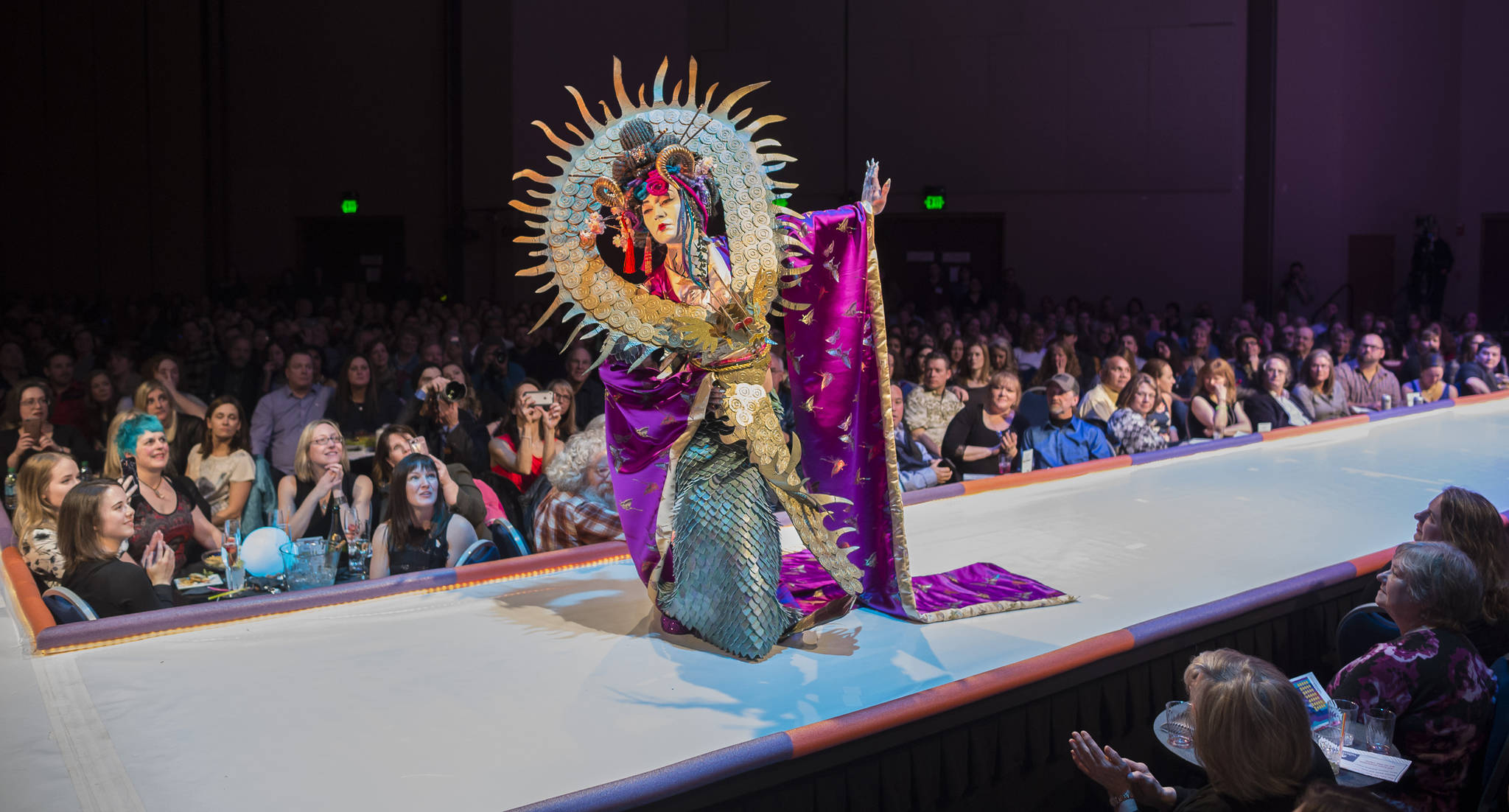The work of artist Beth Bolander has been featured in Juneau’s annual Wearable Art Show for five years, and her contribution to this year’s show sparked a heated discussion about cultural appropriation that led to the piece being removed from Sunday’s show.
Bolander’s piece, entitled “Doragon,” was heavily influenced by Asian artwork and fashion but some say it was promoting stereotypes. The piece included silk, kimono-like fabric as well as a dragon-inspired garment and facial makeup reminiscent of a geisha.
When model Dani Gross took the stage wearing Bolander’s piece Saturday, cheers came from the audience. The piece ended up earning third-place honors. Some, however, weren’t so pleased with what they saw.
[SLIDESHOW: Wearable Art show]
Christy Namee Eriksen, an artist and community activist in Juneau, immediately took issue with the piece. “Culture is not a costume,” she wrote in a Facebook post that has been shared throughout the online community. She and others approached staff from the Juneau Arts and Humanities Council (JAHC) — the organization that runs the Wearable Arts Show — and outlined their concerns with the piece.
Eriksen’s argument was that “Doragon” was an example of cultural appropriation. The act of adopting certain elements of another culture without the consent of those who belong to that culture is the common definition of cultural appropriation. The act can be carried out in numerous ways, through artwork, fashion, dialects and more.
Nancy DeCherney, the executive director of the JAHC, said there was enough resistance to the piece that she and her coworkers decided to pull the piece from the Sunday showing.
“We came to the conclusion that if there was going to be a lot of hostility coming at the model, it was best to not put her on the runway,” DeCherney said.
The piece was displayed in the lobby after the Sunday show. Bolander, who is from Haines, said she did not think her artwork was appropriating culture, and she never intended to disrespect anyone else with the artwork.
“I was simply inspired by other cultures and did my best to create something beautiful that was represented with style, respect and grace by my model,” Bolander said. “She nailed all of that.”
Bolander said she’s received a great deal of positive feedback on the piece, with friends and strangers claiming their support for the artwork. DeCherney said her email inbox and phone were very busy Monday, with people on both sides of the argument offering their views.
A larger issue
The issue of cultural appropriation stretches far beyond this weekend’s art show, and is a familiar topic in Southeast Alaska. With the popularity of Alaska Native artwork, there have been various documented cases of non-Native individuals taking Native techniques and making them their own.
In early 2016, two shop owners in Juneau were tied to a Native art scam that misrepresented artwork as being made by Alaska Natives when it was made by non-Native artists. Both pleaded guilty to violating the Indians Arts and Craft Act of 1935, which made it illegal to sell artwork that is falsely advertised as indigenous.
Neither Bolander nor Gross are of Asian descent, which played a part in the backlash. Juneau resident Akemi Kunibe, who is of Japanese descent, saw the artwork as perpetuating stereotypes about Asian culture and artwork. She also felt that displaying the piece in the context of the Wearable Arts Show was “glorifying” the appropriation.
Both Eriksen and Kunibe said this reaction is not just about a few people being offended at the piece.
“Cultural appropriation is not a new concept that we’re bringing up for the first time,” Kunibe said. “This is something a lot of people have discussed.”
That ongoing discussion, DeCherney said, will hopefully be continuing in a more organized fashion in the near future. She said she has spoken with Kolene James, the coordinator of the Native and Rural Student Center (NRSC) at the University of Alaska Southeast and her husband Lyle James, who is the youth projects coordinator at Goldbelt Heritage Foundation, about possibly heading up a series of speeches and discussions to dive into the issue of appropriation.
DeCherney would like to see monthly talks, each with a different focus within the realm of cultural appropriation. Kunibe said she would be interested in that idea, as long as the viewpoints of those whose culture had been appropriated were represented.
“It’s time for the community to talk,” DeCherney said, “and see how we can uphold each other in a respectful manner and do really good work together.”
Wearable Art Show winners
First place: “Siren” by KD Roope, modeled by Ryia Waldern
Second place: “disMANTLE” by Lauralye Miko, modeled by Amy Valentine
Third place: “Doragon” by Beth Bolander, modeled by Dani Gross
People’s Choice winner: “Phlight of the Phoenix” by Kathleen Harper and Annie Szeliski, modeled by Stacy Katasse
• Contact reporter Alex McCarthy at 523-2271 or alex.mccarthy@juneauempire.com. Follow him on Twitter at @akmccarthy.

